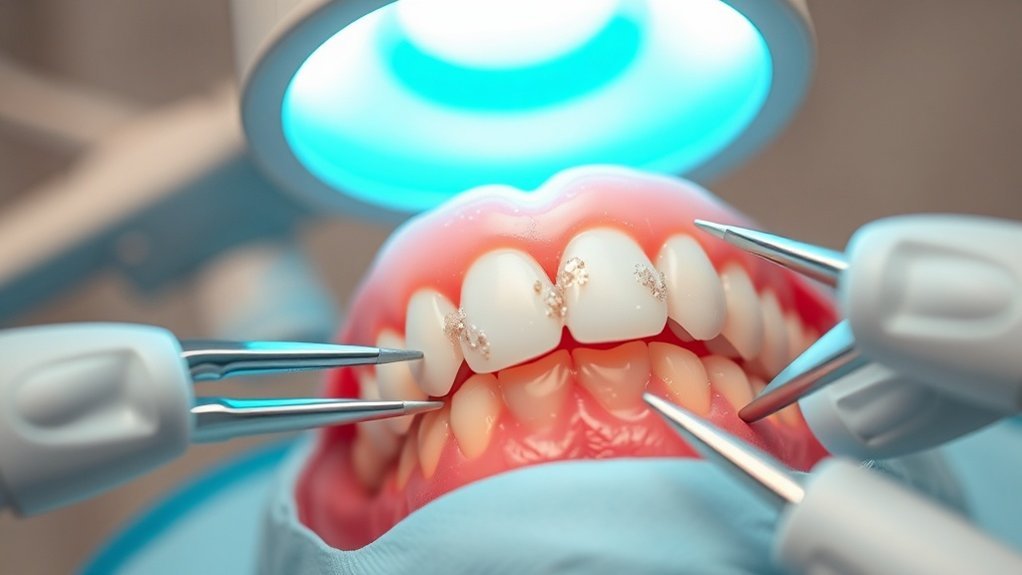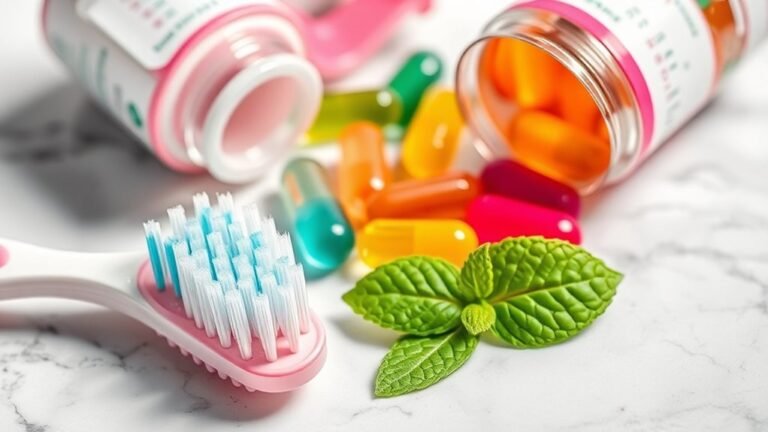Early Plaque Detection Prevents Severe Tooth Decay and Cavities
Early detection of plaque is crucial in preventing severe tooth decay and cavities. Plaque forms when bacteria from food particles create a sticky film on your teeth. Ignoring early signs, like a sticky feeling or slight discoloration, can lead to painful tooth decay and gum disease. By maintaining a consistent oral hygiene routine, including brushing and flossing, and scheduling regular dental check-ups, you can effectively safeguard your oral health. Discover how to enhance your plaque prevention strategies.
Key Takeaways
- Early detection of plaque helps prevent its hardening into tartar, reducing the risk of severe tooth decay.
- Regular dental check-ups enable timely identification of plaque and oral health issues before they escalate.
- Noticing early signs of plaque, such as bad breath or gum sensitivity, can lead to prompt action and prevention.
- Effective daily oral hygiene practices, like brushing and flossing, aid in the early removal of plaque buildup.
- Advanced technologies, such as fluorescence imaging, enhance the ability to detect hidden plaque, facilitating early intervention.
Understanding Plaque: What It Is and Why It Matters
Plaque is a sticky film of bacteria that forms on your teeth and gums, and understanding its nature is fundamental for maintaining oral health. Early plaque detection is important because it allows you to identify and address plaque buildup before it leads to more severe issues. When plaque isn’t removed, it can harden into tartar, increasing your risk of tooth decay. By recognizing the early signs of plaque, you can take proactive steps towards tooth decay prevention and cavity prevention. Regular brushing, flossing, and dental check-ups play pivotal roles in keeping plaque in check. Staying informed about plaque’s impact on your dental health empowers you to maintain a brighter, healthier smile and reduces your chances of experiencing painful dental problems down the road.
The Process of Plaque Formation
Plaque formation begins with the growth of bacteria in your mouth, which thrive on food particles, particularly sugars. As you consume sugary foods, these bacteria multiply, producing acids that can damage your tooth enamel. Understanding this process is essential for preventing plaque buildup and maintaining oral health.
Bacterial Growth Dynamics
When bacteria colonize your teeth, they initiate a complex process that ultimately leads to plaque formation. This process begins with the adhesion of bacteria to the tooth surface, where they multiply rapidly, forming a biofilm. As these bacteria thrive, they produce a matrix of polysaccharides, which helps them stick to the teeth and each other, creating a dense layer of plaque. This biofilm serves as a reservoir for harmful bacteria, contributing to oral health issues. Effective oral care, including regular brushing and flossing, disrupts this bacterial growth, preventing plaque from hardening into tartar. Staying vigilant with your oral hygiene routine is crucial to control bacterial dynamics and maintain a healthy mouth, safeguarding against potential decay and cavities.
Role of Sugars
The presence of sugars in your diet plays an essential role in the formation of plaque on your teeth. When you consume sugary foods or drinks, the bacteria in your mouth feed on these sugars, producing acids as a byproduct. These acids attack your tooth enamel, leading to demineralization and, ultimately, cavities. Over time, the bacteria multiply, forming a sticky biofilm known as plaque. If you don’t remove this plaque through regular brushing and flossing, it hardens into tartar, making it even more challenging to eliminate. To protect your teeth, it’s vital to limit sugar intake and maintain a consistent oral hygiene routine. By doing so, you can greatly reduce plaque formation and the risk of severe tooth decay.
Early Signs of Plaque Buildup
As you maintain your oral health, recognizing early signs of plaque buildup can considerably enhance your preventive efforts. One of the first indicators is a sticky feeling on your teeth, particularly after eating. You might also notice a slight discoloration, often appearing as a film that can be white or yellow. Pay attention to increased bad breath, which can signal bacterial growth. Additionally, your gums may become red or swollen, especially if they bleed when you brush or floss. If you experience any sensitivity to hot or cold foods, it could be another sign of plaque accumulation. By identifying these symptoms early, you can take action to improve your oral hygiene routine and prevent more serious dental issues.
The Consequences of Ignoring Plaque
Ignoring plaque can lead to serious dental issues, including an increased risk of cavities. As plaque hardens, it creates an environment ripe for gum disease development, which can cause further complications for your oral health. Staying proactive about plaque removal is essential to prevent these consequences.
Increased Risk of Cavities
Neglecting plaque buildup considerably heightens your risk of developing cavities, as the bacteria within plaque produce acids that erode tooth enamel. Over time, this erosion leads to the formation of holes in your teeth, resulting in painful decay and expensive dental treatments. Understanding the consequences of ignoring plaque can motivate you to prioritize oral hygiene.
| Consequence | Description | Prevention |
|---|---|---|
| Enamel Erosion | Bacteria produce acids that wear down enamel. | Regular brushing/flossing |
| Cavities | Holes in teeth caused by decay. | Routine dental check-ups |
| Pain and Discomfort | Sensitivity and discomfort from decay. | Early plaque detection |
Taking proactive steps can considerably reduce your risk of cavities and promote a healthier smile.
Gum Disease Development
When plaque is left untreated, it can lead to gum disease, a serious condition that affects your oral health. Ignoring plaque buildup can result in various complications, including:
- Inflammation: Your gums become swollen and red, leading to discomfort and sensitivity.
- Recession: Over time, your gums may start to pull away from your teeth, exposing sensitive areas and increasing decay risk.
- Tooth Loss: Advanced gum disease can destroy the supporting structures of your teeth, potentially resulting in tooth loss.
Recognizing the signs early and maintaining good oral hygiene can prevent these issues. Regular dental check-ups and a consistent cleaning routine are essential in keeping gum disease at bay and ensuring long-term oral health.
Effective Daily Oral Hygiene Practices
How can you secure your mouth stays healthy and free from plaque buildup? Start with brushing twice a day using fluoride toothpaste. Make sure you brush for at least two minutes, covering all surfaces of your teeth. Don’t forget to use a soft-bristled toothbrush to protect your gums. Floss daily to remove food particles and plaque between teeth where your brush can’t reach. Consider using an antimicrobial mouthwash to further reduce plaque and bacteria. Regular dental check-ups are vital; visit your dentist every six months for professional cleanings and exams. Finally, be mindful of your technique; proper brushing and flossing methods are fundamental for effective plaque control. Implementing these practices consistently will help maintain peak oral health.
Dietary Choices That Impact Plaque Development
Your dietary choices play an essential role in plaque development, particularly when it comes to sugary foods and beverages. Consuming high amounts of sugar can lead to an increase in harmful bacteria that form plaque on your teeth. Additionally, acidic food choices can erode enamel, making your teeth more susceptible to plaque buildup.
Sugary Foods and Beverages
Sugary foods and beverages play a significant role in the development of dental plaque, with studies showing that high sugar consumption can increase the risk of oral health issues. When you consume sugary items, the bacteria in your mouth feed on these sugars, producing acids that can harm your teeth. Consider the following:
- Sodas and Sweetened Drinks: These beverages not only contain high sugar levels but also promote plaque formation.
- Candy and Sweets: Sticky candies cling to your teeth, providing a prolonged source of sugar for bacteria.
- Pastries and Desserts: These often combine sugar with carbohydrates, creating an ideal environment for plaque buildup.
Acidic Food Choices
While many people focus on sugar as a primary culprit in plaque formation, acidic food choices can also greatly impact oral health. Foods like citrus fruits, tomatoes, and vinegar-based dressings can lower the pH in your mouth, creating an environment where harmful bacteria thrive. These bacteria produce acids that erode enamel, leading to plaque buildup and potential cavities. It’s important to be mindful of your diet; after consuming acidic foods, rinse your mouth with water to neutralize the acids. Additionally, try to pair acidic foods with alkaline options, like cheese or nuts, to help balance your oral pH. By making informed dietary choices, you can considerably reduce the risk of plaque development and protect your teeth.
The Role of Regular Dental Check-ups
Regular dental check-ups play an essential role in maintaining oral health, as they provide an opportunity for professionals to identify early signs of plaque buildup before it leads to more serious issues. By attending these appointments, you can guarantee your teeth and gums remain healthy. Here are three key benefits of regular check-ups:
- Early Detection: Dentists can spot plaque and other oral health issues before they escalate.
- Personalized Advice: You receive tailored recommendations on your oral hygiene routine, helping you improve your practices.
- Preventive Care: Regular visits can lead to preventative measures, reducing the risk of cavities and decay.
The Importance of Professional Cleanings
Although brushing and flossing are essential for your daily oral care, professional cleanings are equally important for maintaining peak dental health. These cleanings allow dental professionals to remove plaque and tartar buildup that your regular routine might miss. They also help in identifying early signs of gum disease or decay.
| Benefit | Description | Frequency |
|---|---|---|
| Plaque Removal | Removes stubborn plaque and tartar | Every 6 months |
| Gum Health Monitoring | Checks for signs of gum disease | Every 6 months |
| Oral Cancer Screening | Early detection of potential issues | Annually |
| Personalized Advice | Tailored tips for your oral hygiene | Every visit |
| Fresh Breath | Eliminates bad breath-causing bacteria | After each cleaning |
Engaging in regular professional cleanings can greatly enhance your oral health and prevent serious dental issues.
Advanced Technologies for Plaque Detection
As dental technology continues to evolve, advanced methods for plaque detection are enhancing your ability to maintain ideal oral health. These innovative technologies help identify plaque buildup early, allowing for timely intervention and prevention of tooth decay. Here are three cutting-edge methods currently in use:
- Fluorescence Imaging: This technique uses special light to reveal plaque and calculus that may not be visible to the naked eye.
- Digital X-rays: Offering a clearer view of your teeth and gums, digital X-rays can pinpoint areas where plaque may accumulate, enabling proactive treatment.
- Intraoral Cameras: These small cameras provide real-time images inside your mouth, helping both you and your dentist visualize problem areas more effectively.
Embracing these technologies can markedly improve your oral hygiene routine.
Building a Long-term Plaque Prevention Routine
To maintain ideal oral health, it’s vital to establish a long-term plaque prevention routine that fits seamlessly into your daily life. Start by brushing your teeth twice a day with fluoride toothpaste, ensuring you cover all surfaces. Don’t forget to floss daily; it removes plaque and food particles from between your teeth where brushes can’t reach. Incorporate an antimicrobial mouthwash to further reduce plaque buildup. Regular dental check-ups are fundamental; schedule appointments every six months for professional cleanings and assessments. Additionally, limit sugary snacks and beverages, as they contribute to plaque formation. Stay hydrated and chew sugar-free gum to stimulate saliva production, which naturally helps wash away debris. Consistency is key; make these habits part of your daily routine for lasting results.
Frequently Asked Questions
Can Children Be More Susceptible to Plaque Buildup Than Adults?
Yes, children can be more susceptible to plaque buildup than adults due to factors like developing oral hygiene habits, diet, and uneven tooth surfaces. Regular dental check-ups and proper brushing can help manage this risk effectively.
How Often Should I Replace My Toothbrush for Effective Plaque Removal?
You should replace your toothbrush every three to four months or sooner if bristles are frayed. Regularly changing your toothbrush guarantees effective plaque removal and maintains the best oral hygiene for a healthier smile.
Are There Specific Mouthwashes That Help Prevent Plaque?
Think of mouthwash as your trusty shield in the battle against plaque. Yes, specific mouthwashes with antibacterial ingredients can help prevent plaque buildup. Look for those containing chlorhexidine or cetylpyridinium chloride for ideal protection.
What Are the Best Foods to Promote Healthy Teeth and Reduce Plaque?
To promote healthy teeth and reduce plaque, you should eat crunchy fruits and vegetables, like apples and carrots, dairy products for calcium, and nuts. These foods stimulate saliva production, which naturally cleans your teeth.
How Does Stress Impact Oral Health and Plaque Formation?
Stress acts like a storm cloud, brewing chaos in your mouth. When you’re stressed, your body produces more cortisol, which can lead to increased plaque formation and gum inflammation, compromising your oral health and overall well-being.
Conclusion
In the battle against tooth decay, early plaque detection is your first line of defense. Just as a gardener tends to weeds before they overrun a garden, regularly monitoring your oral health can prevent severe consequences. By practicing effective hygiene, scheduling regular check-ups, and embracing modern detection technologies, you’ll cultivate a vibrant smile that thrives. Remember, maintaining your dental health isn’t just a task; it’s a commitment to a lifetime of well-being.






